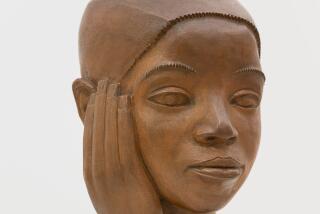ART REVIEW : SEEING âDOUBLEâ IN DONALD SULTAN EXHIBIT
Experience tells us that a lemon is a yellow citrus fruit with a thick, bumpy skin and a sour taste--terrific in small doses but too potent to be consumed in large quantities. Donald Sultan sees lemons another way: as black, fuzzy, voluptuous shapes that grow bigger than watermelons and flaunt themselves as fertility symbols.
Six of his giant âBlack Lemonâ aquatints (about 5 feet tall and 4 feet wide) anchor opposite walls of a gallery at Cal State Long Beachâs University Art Museum and dominate Sultanâs show of prints from 1979 to 1985.
We know that Sultanâs shaggy black objects are lemons by the nubbins that protrude from their oval shapes, but otherwise they have nothing in common with those neglected things that shrivel up into brown rocks or turn green and squishy in our refrigerators. Judged by the velvet density of their blacks, these fruits might be oversized lumps of coal; their contours and ânipplesâ suggest breasts, while soft edges guarantee that some viewers will note an affinity to curled up cats whose shedding fur drifts into the space around them.
Like most of the New York artistâs work, the lemon prints neither confirm something familiar about an ordinary object nor reveal a little-noticed truth. They say nothing at all about the lemons we know and ignore--and everything about artâs ability to transform the mundane into an entity that takes off in its own orbit.
Sultanâs powers of transformation in this case are the result of medium, scale and style. Instead of taking the Chuck Close approach and exposing every imperfection in microscopic detail as he enlarges his subject, Sultan obliterates all the particulars, cancels the color and invests the work with sensuous subtleties of printmaking.
Both the big lemons and four tiny prints of âBlack Tulipsâ are aquatints that emulate soft-edge charcoal drawings. To do them, Sultan worked out a method of blowing and brushing resin powder on a printing plate before heating it. For the outsized lemons, he blew through long tubes and blurred edges of shapes with delicate Japanese brushes. The results are wonders of printmaking that retain the surface interest of drawings.
The remainder of the show consists of small linocuts and aquatints covering other themes that--like the lemons and tulips--Sultan has carried out in paintings. Most of these prints are crisp, architectonic images that invite double readings.
Apparently simple--even crude--yet oddly elegant, the prints reveal a fascination with metamorphosis. The spaces between imposing buildings are âCanyons.â âSmokersâ represent both smokestacks and cigarettes. Sultanâs âWater Under the Bridgeâ portfolio includes a âBoat/Tableâ and âSailor Hatsâ that resemble toy boats and fruit juicers.
Amid another group of prints, a white triangular shape on a black background is an âIceberg/Boat Prow,â while an aquatint containing a large triangle at the bottom of a black square and a tiny half-moon centered above it is called âNavel and Panties/Lake and Moon.â
A summer in the South of France produced simple linocut images of cypresses (which Sultan jokingly calls âpicklesâ) and a group of âFrench Stacks,â which could be flower stalks as well as towering smokestacks. In these, as well as in linocuts of irises, he runs the same image through a variety of color treatments while preserving high contrast and graphic clarity. Far from realistic, these prints nonetheless convey something essential about the subject--the graceful sweep of petals or the imposing verticality of smokestacks--while presenting them as a new reality.
On one hand, this work is about as straightforward as art can be. On the other, it is so fundamentally equivocal that it causes us to question the very notion of mundane objects. Artists have been doing that for centuries, but they donât often do it so directly.
The exhibition (through Feb. 22) is part of the universityâs âCentricâ series of small contemporary shows of work not previously seen in Southern California. We will get a broader view of Sultan when the Museum of Contemporary Art hosts his solo show at the Temporary Contemporary from Nov. 24 to Jan. 10, 1988.
The University Art Museum is open Tuesday through Friday, 11 a.m. to 5 p.m. and closed weekends through Jan. 26, when classes resume. After Jan. 26, the museum also will be open on Sundays from 1 to 5 p.m. Parking information: (213) 498-5761.
More to Read
The biggest entertainment stories
Get our big stories about Hollywood, film, television, music, arts, culture and more right in your inbox as soon as they publish.
You may occasionally receive promotional content from the Los Angeles Times.










